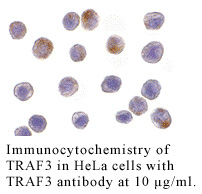Anti-Human TNF Receptor-Associated Factor 3 (CT-2) (TRAF3)
Anti-Human TNF Receptor-Associated Factor 3 (CT-2) (TRAF3)
Product No.: T285
- -
- -
Target TNF Receptor-Associated Factor 3 Product Type Polyclonal Antibody Alternate Names CD40 Binding Protein, LMP1 Associated Protein 1, CD40BP, LAP1 Applications IHC FFPE , WB |
Data
- -
- -
Antibody DetailsProduct DetailsReactive Species Human Host Species Rabbit Product Concentration 0.5 mg/ml Formulation This polyclonal antibody is formulated in phosphate buffered saline (PBS) pH 7.4 containing 0.02% sodium azide as a preservative. Storage and Handling This polyclonal antibody is stable for at least one week when stored at 2-8°C. For long term storage, aliquot in working volumes without diluting and store at –20°C in a manual defrost freezer. Avoid Repeated Freeze Thaw Cycles. Country of Origin USA Shipping Next Day Ambient RRIDAB_2831882 Each investigator should determine their own optimal working dilution for specific applications. See directions on lot specific datasheets, as information may periodically change. DescriptionDescriptionSpecificity Rabbit Anti-Human TNF Receptor-Associated Factor 3 (TRAF3) recognizes an epitope near the C-terminus of Human, Mouse and Rat TRAF3. This polyclonal antibody was purified using affinity chromatography. Background Tumor necrosis factor (TNF) receptor associated factors (TRAFs) are the major signal transducers for the TNF receptor superfamily and the interleukin-1 receptor/Toll-like receptor (IL-1/TLR) superfamily.1 TRAF3 was first identified by its interaction with CD40 and the Epstein-Barr virus transforming protein LMP1.2,3 Several TRAF3 mRNA splice variants exist and some of these can activate the transcription factor NF-κB.4 Besides CD40, TRAF3 also interacts with the TRFR superfamily member lymphotoxin-β receptor (LTβR) in association with TRAF2 and the apoptosis inhibitors cIAP1 and Smac. It has been suggested that TRAF3 induces mitochondria-mediated apoptosis upon binding of the TNF family cytokine LIGHT by LTβR. References & Citations1. Arch, RH. et al. (1998) Genes Dev. 12:2821 2. Cheng, G. et al. (1995) Science 267:1494 3. Mosialos, G. et al. (1995) Cell 80:389 4. van Eyndhoven, WG. et al. (1999) Mol. Immunol. 36:647 Technical ProtocolsCertificate of Analysis |
Related Products
- -
- -




